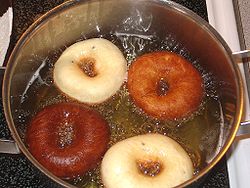
A doughnut or donut is a type of food made from leavened fried dough. It is popular in many countries and is prepared in various forms as a sweet snack that can be homemade or purchased in bakeries, supermarkets, food stalls, and franchised specialty vendors. Doughnut is the traditional spelling, while donut is the simplified version; the terms are used interchangeably.
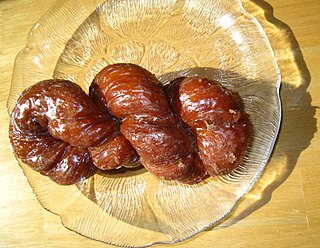
A cruller is a deep-fried pastry like a doughnut popular in Europe and North America often made from a rectangle of dough with a cut made in the middle that allows it to be pulled over and through itself, producing twists in the sides of the pastry. The cruller has been described as resembling "a small, braided torpedo". Some other cruller styles are made of a denser dough somewhat like that of a cake doughnut formed in a small loaf or stick shape, but not always twisted. Crullers may be topped with powdered sugar or icing.

Funnel cake is a regional sweet food popular in North America, found mainly at carnivals and amusement parks. It is made by deep-frying batter.

Fried dough is a North American food associated with outdoor food stands in carnivals, amusement parks, fairs, rodeos, and seaside resorts. "Fried dough" is the specific name for a particular variety of fried bread made of a yeast dough; see the accompanying images for an example of use on carnival-booth signs. Fried dough is also known as fry dough, fry bread (bannock), fried bread, doughboys, elephant ears, beaver tails, scones, pizza fritte, frying saucers, and buñuelos. These foods are virtually identical to each other and some yeast dough versions of beignets, and recognizably different from other fried dough foods such as doughnuts or fritters.
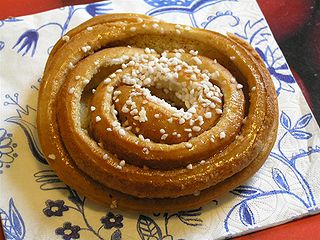
A cinnamon roll is a sweet roll commonly served in Northern Europe and North America. In Sweden it is called kanelbulle, in Denmark it is known as kanelsnegl, in Norway it is known as kanelbolle, skillingsbolle or kanelsnurr, in Finland it is known as korvapuusti, in Iceland it is known as kanilsnúður, and in Estonia it is known as kaneelirull. In Austria and Germany it is called Zimtschnecke.
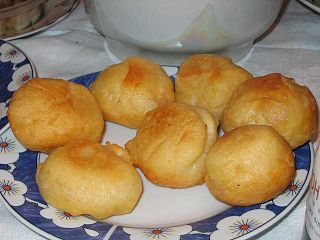
Pampúshka is a small savory or sweet yeast-raised bun or doughnut typical for Ukrainian cuisine.

Æbleskiver are spherically-shaped Danish snacks made from fried batter. The name literally means "apple slices" in Danish, although apples are not usually an ingredient in present-day versions. The crust is similar in texture to European pancakes, but with a light and fluffy interior similar to a Yorkshire pudding. The English language spelling is usually aebleskiver,ebleskiver or ebelskiver.
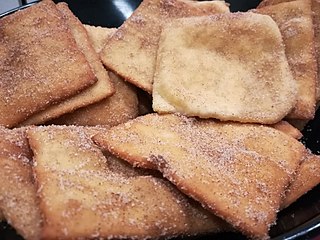
A sopaipilla, sopapilla, sopaipa, or cachanga is a kind of fried pastry and a type of quick bread served in several regions with Spanish heritage in the Americas. The word sopaipilla is the diminutive of sopaipa, a word that entered Spanish from the Mozarabic language of Al-Andalus. The original Mozarabic word Xopaipa was used to mean bread soaked in oil. The word is derived in turn from the Germanic word suppa, which meant bread soaked in liquid.

A Berliner is a German jelly doughnut with no central hole, made from sweet yeast dough fried in lard or cooking oil, with a jam filling, and usually covered in powdered or conventional sugar.

A buñuelo is a fried dough fritter found in Spain, Latin America, and other regions with a historical connection to Spaniards, including Southwest Europe, the Balkans, Anatolia, and other parts of Asia and North Africa. Buñuelos are traditionally prepared at Christmas. It will usually have a filling or a topping. In Mexican cuisine, it is often served with a syrup made with piloncillo.
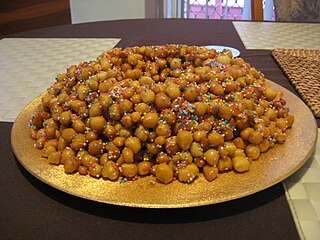
Struffoli also known as Honey Balls is a Neapolitan dish made of deep fried balls of sweet dough. The dough is used in many Italian sweet treats such as chiacchiere. For struffoli, the dough is formed in to balls about the size of marbles. Crunchy on the outside and light inside, struffoli are mixed with honey and other sweet ingredients and formed into mounds or rings. There are many different ways to flavour them, but the traditional way is to mix them in honey with diavulilli, cinnamon, and bits of orange rind. Naming varies by region: in Calabria they are also known as scalilli, and in Abruzzo cicerchiata. They are often served at Christmas and are sometimes served warm.

Potato doughnuts, sometimes called a Spudnut, are a type of doughnut, typically sweet, made with either mashed potatoes or potato starch instead of flour, the most common ingredient used for doughnut dough. Potato doughnuts tend to be lighter than all-flour doughnuts, and are prepared in a similar way as other doughnuts. A chain of Spudnut Shops was established across the United States in the 1930s before declining to a few dozen more recently. Fried ube dough is also eaten in East Asia, including the world's most expensive doughnut, the Golden Cristal Ube, which cost $100 each. Much like flour doughnuts, potato doughnuts are often eaten with coffee.
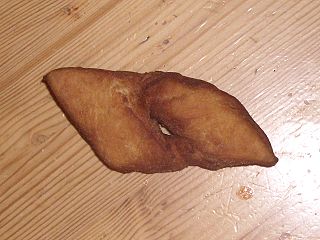
Klenät, kleinur, klena, klejne, kleina, kleyna, and fattigmann are all names for Angel wings, a fried pastry common in the Nordic countries as well as the rest of Europe and the United States. In nearby countries and Eastern European countries. The name is related to klen, the Swedish term for "slender", but is originally of Low German origin, which may indicate that the pastry was originally German. It is made from flattened dough cut into small trapezoids. A slit is cut in the middle and then one or both ends pulled through the slit to form a "knot". The kleina is then deep-fried in oil or another kind of fat. Subsequently can be sprinkled with powdered sugar and cinnamon.

The old-fashioned doughnut is a term used for a variety of cake doughnut prepared in the shape of a ring with a cracked surface and tapered edges around it. Nineteenth century recipes for "old-fashioned donuts" are made with yeast, but in modern doughnut shops an "old-fashioned doughnut" is usually a cake doughnut. Cake doughnuts made with chemical leavener originated in the United States circa 1829. Primary ingredients in the old-fashioned doughnut include flour, sugar, butter, eggs, sour cream or buttermilk, and chemical leavener. It is typically deep fried, may have a crunchier or crisper texture compared to other styles of cake doughnuts, and typically has cracks and pores on its surface. After being fried, it is glazed, dusted with sugar, or served plain.
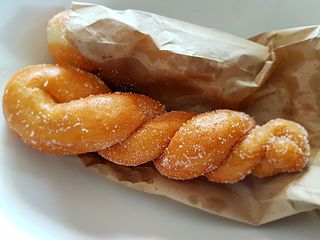
Twisted doughnuts are yeast donuts or sticks of pastry made from wheat flour or glutinous rice flour, deep-fried in oil. In China, they are known as mahua (麻花); in Korea, they are known as kkwabaegi (꽈배기) in the Philippines, they are known as shakoy and pilipit, in Japan, they are known as sakubei.

A koesister or koe'sister is a traditional Cape Malay pastry often described as a spicy dumpling with a cake-like texture, finished off with a sprinkling of coconut.
